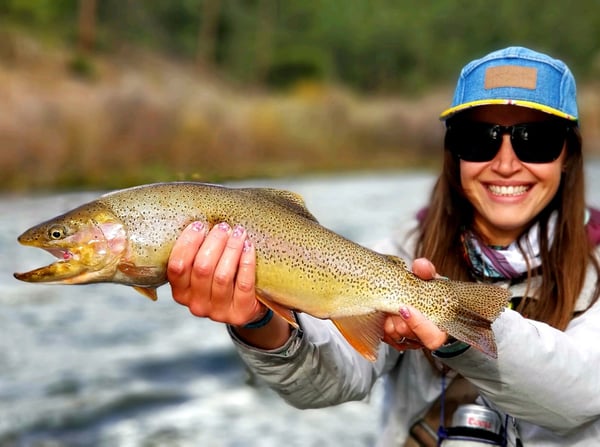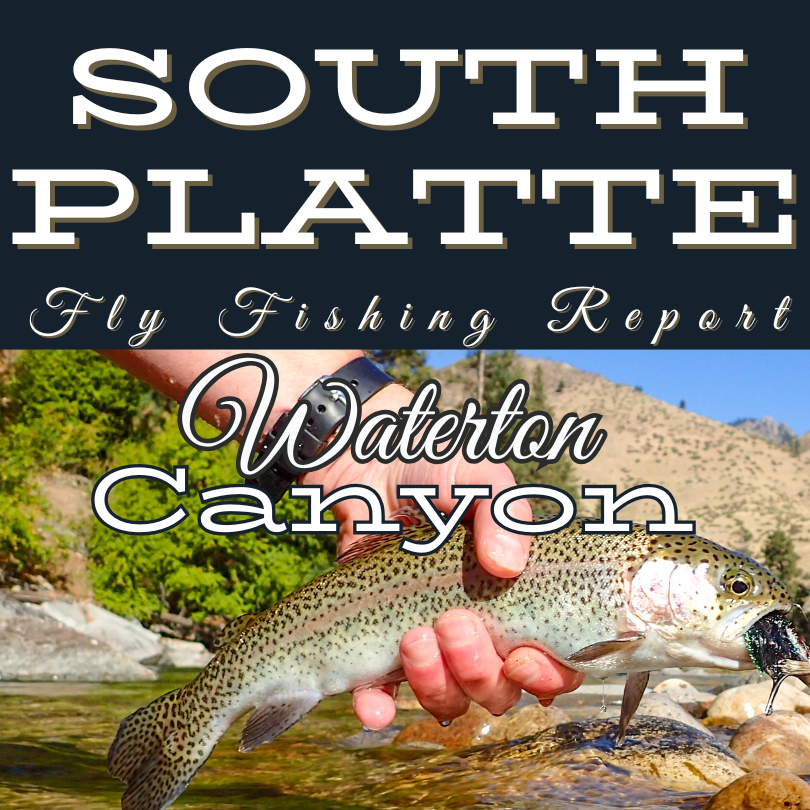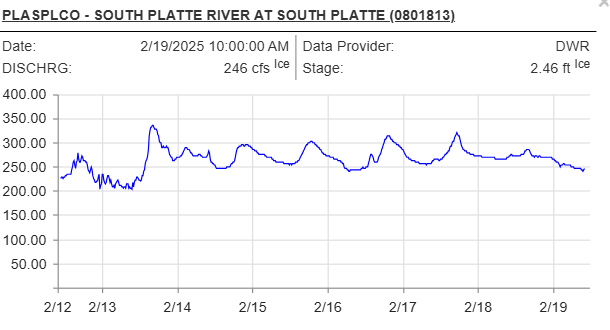The river is cold, lightly stained to clear, and moving slower than the main stem, with trout set up in soft winter lanes and deep inside bends. Feeding windows are short but forgiving compared to Cheesman or Deckers, especially during calm afternoons. This is classic North Fork South Platte winter fly fishing: quieter water, fewer anglers, and steady opportunity if you slow down.

Updated: December 15, 2025
The North Fork of the South Platte River settles into a very different winter rhythm than the main South Platte tailwater sections. Lower gradient water, broader bends, and softer structure allow trout to hold comfortably without fighting current. Flows fluctuate slightly with weather, but overall conditions remain stable enough to pattern fish day to day.
This week’s update for North Fork South Platte fly fishing emphasizes water choice and subtlety. Midges remain the primary food source, but scuds and small leeches play a larger role here than upstream. Focus on deeper edges, slow inside seams, and transitional water where fish can feed efficiently with minimal movement.
Listen to the Audio Overview
Conditions Summary
%20(3).png?width=800&height=175&name=Guide%20Rating%20(800%20x%20175%20px)%20(3).png)
Flow: Variable but generally low winter flow
Water Temperature: Low to mid 30s
Air Temperature: High 30s to low 40s during the day, colder mornings
Clarity: Clear to slightly stained depending on weather
Crowds: Very light in winter
Best Window: 12 p.m. to 4 p.m.
Fishing Type Focus: Winter nymphing with midges, scuds, and subtle streamers
Weather
Bailey Colorado Weather
Cold mornings give way to mild afternoon warming, especially on sunny days. Light cloud cover can extend feeding windows, while storms can temporarily reduce clarity but often improve the bite once flows settle.
Top Flies in Your Box This Week
- Black Beauty 20 to 24
- Zebra Midge (black or red) 18 to 22
- Mercury Midge 20 to 22
- RS2 (black or gray) 20 to 22
- Scud (olive or gray) 14 to 16
- Small Pheasant Tail 18 to 20
- Mini Leech (black or olive) 12 to 14
Pro Rig of the Week: North Fork Soft-Edge Rig
- Indicator: Small yarn or minimal air-lock
- Lead Fly: Scud 14 to 16 or Small Pheasant Tail 18
- Dropper: Black Beauty or Zebra Midge 20 to 22
- Weight: Light to moderate, adjusted for slower depth
Hatch Chart for December
| Bug Type | Size | Notes |
|---|---|---|
| Midges | 18 to 24 | Primary winter food source |
| Scuds | 12 to 16 | Very important protein source |
| Leeches | 10 to 14 | Effective in deeper slower water |
Download the South Platte Hatch Chart
Access Points
1. Bailey Canyon Bridges
Why Fish Here: Good depth, consistent winter holding water
Crowds: Medium
Rating: ⭐⭐⭐⭐
Notes: Perfect place to start at these flows.
2. Shawnee Riffle to Run Sequences
Why Fish Here: Riffle drop offs into deeper green slots
Crowds: Light to medium
Rating: ⭐⭐⭐⭐
Notes: Best midday midge water.
3. Below the Big Cutbanks
Why Fish Here: Deep slow wintering water
Crowds: Medium
Rating: ⭐⭐⭐⭐
Notes: Excellent place for the pro rig or small leech swings.
Access Points
Bailey Town Stretch ⭐⭐⭐⭐⭐
Consistent winter structure with soft seams and excellent holding water.
Rating: Five gold stars
Pine Area Pullouts ⭐⭐⭐⭐☆
Broader bends and slower water that fish well in cold conditions.
Rating: Four gold stars
Upper North Fork Sections ⭐⭐⭐⭐☆
More technical water with lighter pressure and strong winter holding lies.
Rating: Four gold stars
Local Regulations And Landowner Notes
- Respect private sections in the Bailey corridor
- Only use designated access points
- Winter flows can fluctuate; check before wading tight slots
Stop Here After The River
A classic warm-up spot after a cold canyon day. Cozy cabin vibe, wood-fired pizzas, good burgers, and the kind of hot coffee that brings your hands back to life. Order the wood-fired pepperoni or the bacon cheeseburger and give yourself a minute to thaw before the drive home.
Photo of the Month
Credit: Colorado Trout Hunters
Book Colorado Trout Hunters for Private Waters and Top access along the South Platte
FAQ
Q: What flows fish best this time of year
A: 150 to 250 CFS is ideal and 200 CFS is nearly perfect.
Q: Are dries realistic
A: Only during brief calm windows; otherwise stick to nymphs.
Q: What is the best time of day
A: Midday once the canyon warms and light reaches the river floor.
Q: Is the water crowded right now
A: Medium pressure, more on warm weekends, lighter during colder snaps.
Q: Should I run 6x
A: Yes on your dropper, especially with size 22 to 24 midges.
Q: Are streamers a real option
A: Yes if fished slowly along deep structure, but nymphing is primary.
.png?width=300&height=100&name=Copy%20of%20Rise%20Beyond%20Logo%2012.31.24%20(300%20x%20100%20px).png)
.png)




